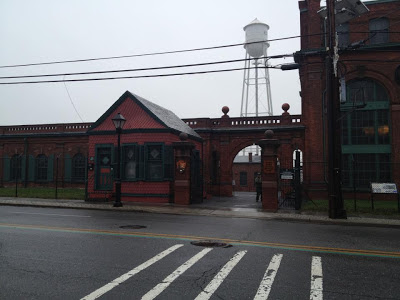How many times does it take to safely vacuum an 18' x 18' projection screen? That was the question we asked ourselves on Tuesday while working on-site at the Thomas Edison National Historical Park in West Orange, NJ.
 |
| Thomas Edison Laboratory, view of original archway and water tower. |
 |
| Thomas Edison Laboratory, Library exterior |
 |
| The screen while rolled. (It is the cylindric tube spanning across the top of the clock and upper windows.) |
 |
| The screen fully unrolled |
Working along, I proceeded to vacuum ever higher with the assumption that when I reached a certain point I would be able to safely proceed with the screen's treatment. However, such was not exactly the case. Within the last year or so the site had discarded their backpack vacuum, as well as their scissor lift. We were then told that it was possible to set up scaffolding behind the screen that would allow me to reach the very top of this immense canvas. But of course, the scaffolding was not available for our use, and no one had a clue where it was.
 |
| Taped attachment |
Now here was the predicament: how do I stand on a ladder while holding a small, but still weighty, piece of equipment for an extended period without risking my life in the process? Holly, one of the park employees, was so kind to find a potential solution to my predicament. She brought a 3M vacuum, which I could swing over my shoulder. However, the 3M vacuum unsurprisingly no longer had any of its original brush attachments or a wand extension. So what did Gwen and I do? We improvised! Holly Marino, who works at the Edison site, brought us a wand attachment from another machine which we taped to the hose, then we taped our brush attachment to the wand!
 |
| Example of 3M vacuum with only crevice tool |
I proceeded to climb up our little step ladder and extend the wand in order to vacuum the backside of the screen as far as I could reach. It was not long before I started to notice significant cramping in my arm and the strap cutting into my left shoulder, not to mention how awkward it was to maneuver with this huge black box swinging freely around my hips catching on everything.
In addition, I could not control the suction power, which not only resulted in an almost deafening noise, but was also not ideal for the artifact. After cleaning what I could reach on three of the six canvas panels, I got down and said, "there has to be a better way to do this!"
On to improvisation part 2. We removed the wand from the now dubbed black box of misery and attempted to attach it to our vacuum, but only to find that the inner ridge on the wand prevented us from simply connecting the two parts. We taped the two together, but it was clear that the contraption was nowhere near strong enough. I indicated to Gwen that I needed a splint of some sort to fix the issue. She looked around our tools and offered first the small 1/8" thick sticks we use for swabbing, then metal micro-spatulas, both of which I rejected as insufficient support for the task saying, "I need more reinforcement than that!" After a few seconds Gwen returned with a small chip brush that I taped to the wand and hose as she held it in place. At this point both of us are giddy with amusement at the lengths we have had to go to so far to come up with a solution. But that was just the beginning.
 |
| "the contraption" |
 |
| Vacuum splint |
 |
| Me at the top of a 10-foot ladder after finally securing the vacuum to the very top. Thank God I'm not afraid of heights! |
Here I am when all is said and done, finally vacuuming after all that hassle, and still with a smile on my face, because after all my effort I was victorious and could proceed with relative ease. The lesson of the story is of course: where there's a will there's a way. And my own personal inspiring quote: "Be the hero with a smile on your face because life is too short to sweat the small stuff, or in this case the big and tall stuff!"
written by Nicolette Cook, Assistant Conservator, Spicer Art Conservation, LLC
Gwen Spicer is a textile conservator in private practice. Spicer Art Conservation specializes in textile conservation, object conservation, and the conservation of works on paper. Gwen's innovative treatment and mounting of flags and textiles is unrivaled. To contact her, please visit her website.